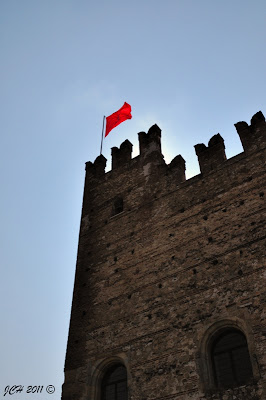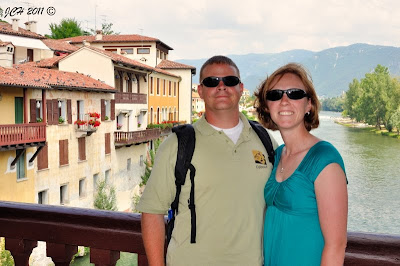The first stop was the town of Marostica, still in the Vicenza area of Italy. This town has very classic Italian design, with the heart of the town protected by a high wall/fortress. The other famous feature of this town is the fact that the town square is laid out like a huge chess board. Every year they put on a human chess match, with knights in full armor and horses, etc. This event is huge, tickets for this year’s was already sold out, but the tourism board was selling tickets for 2012.
This town was so picturesque, with the perfect Italian square. The coffee shops, the scooters (and ATVs) puttering by, and the rich tolling of church bells.
The front entrance to the town had the full castle-like towers, stone structures that have been there for centuries.
Wenonah standing out on the chess board.
The statue of St Mark in the square, which is the patron saint of many towns in Italy.
A memorial to all those in the town that had died in the service of their country. Even though they were an enemy at one point, you still have to respect the memorial and the fallen.
One of the side entrances to the walled portion of the city; I really don’t think my Dodge Ram 3500 would be a good vehicle to own in this town.
The main church within the town, on the slopes of the hill. Everything in the area was made from marble and granite. The church was preparing for a wedding so we couldn’t get inside or too close; Wenonah still tried to poke her head inside.
The ancient marble carved statues that topped every corner and wall around this church were showing their age and the effects of acid rain.
The Bridge of Alpine in Bassano di Grappa at the foot of the Dolemite Mounains, crossing the Brenta River. After the war, the bridge was rebuilt by the local engineering troops, who wear a very particular style hat. The bridge is all wood, except for the foundation in the river.
The guide took a picture of us on the bridge.
Fighting occurred across the river between the allied and axis troops, and the bullet holes were left there as a reminder.
This is the grappa distillery that we toured and sampled at. Of the three couples on the tour, we are the only ones who drank. Why exactly would you sign up for a winery tour if you don’t drink?
This was a collection of all their small bottles of grappa the distillery has sold over the years.
The next town we stopped in was even more beautiful than the first. We walked around the town for a bit before going to the restaurant on this road. It was so quiet and peaceful that I could really move there.
During our walk in the town, we went onto the ramparts of an old monastery, and saw this villa further up the hillside. The architecture allowed it to blend in pretty well, but the large windows gave it away. The real question was the price of this villa.
We stopped at one of the massive old villas that was open as a museum. No photography was allowed on the inside, but all the rooms had full paintings on the walls and ceilings. The old oils were cracking and time was taking its toll but it was still amazing. This is the pool in the backyard and the carved marble bathhouse.
Wenonah under the grape leaves of this vineyard estate.
The Bortolin Gregorio vineyard was our last stop, where we sampled some of their sparkling wine. The parking lot was full of Austrians who come across the border and load up on the wine, filling prados and vans with cases of the wine to take back with them.

















































